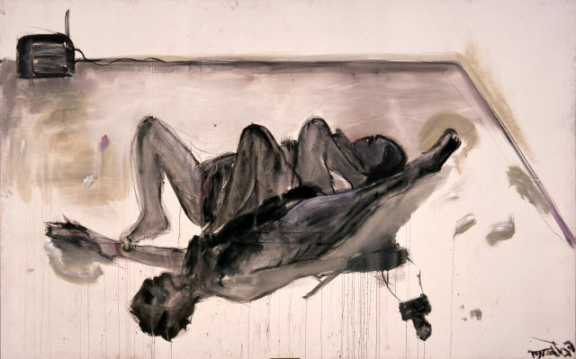
Wolf Vostell
Der Tote der Durst hat
Leverkusen, 1932 – Berlin, 1998
Vostell was a painter, drawer, engraver, sculptor, sculptor of assemblages, father of the Happening in Europe, co-founder of the Fluxus movement in Europe and pioneer (along with Nam June Paik, 1932-2006) of video art. He practiced a critical dialogue between the artist and the world around him through dé-collage, a concept he created in 1954, at the beginning of his career, to signify all the creative possibilities that stem from destruction. Profoundly affected by the genocide perpetrated by the Nazis, he spent over forty years analyzing this “crash of violence, far superior to that of a plane”. Negativity, contestation as critical response to the alienating conditions of reality, violence as a form of expression of the epoch’s spirit (Zeitgeist), the seizure of objects within concrete alluding to situations of immobility, oppression and violence, both physical and psychological, are all characteristic of his discourse.
For Vostell, as for Herbert Marcuse (1898-1979), art is recognized by its interdiction of a “happy end”, acting as a testimony to the radical conscience of the reigning conditions of life. In this sense, the artist can be placed in the art history of his century in line with German Dadaism, Duchamp or French New Realism. Other sources that appear in his conceptual scheme are related to an older history of art, as, according to Vostell, he started to think and feel artistically when he discovered Bosch and mostly Goya, whose work was a constant reference for him.
His relationship with Spain, which came about early on through marriage (1958) and, later, through the construction of the Museo Vostell Malpartida de Cáceres (1976), presented in Documenta 6 (Kassel, 1977), proved, in the effervescent context of the 1970’s and especially the aftermath of the 1974 revolution, to be of particular importance to Portuguese artists such as Ernesto de Sousa (1921-1988). The three Weeks of Contemporary Art of Malpartida (SACOM), organized by Vostell between 1978 and 1983, projected the Iberian Peninsula into the international scene of artistic vanguard of the post-war period.
ILC
May 2010